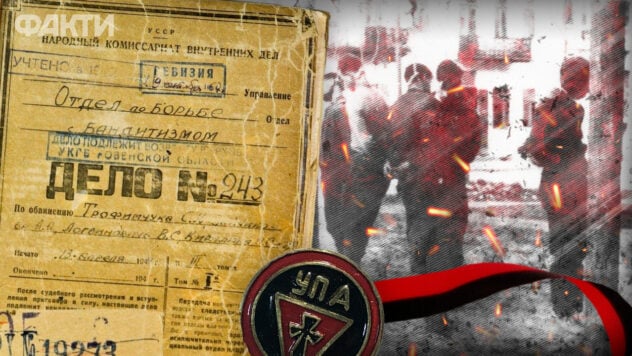 < /p>
< /p>
On January 4, 1944, the occupation authorities of the Third Reich in Rivne executed underground workers by hanging on Theater Square in the city. Exactly a year later, on the same day, on the same square, using the same method, the crime against Ukrainians was repeated. Only this time the executioners were other occupiers — from Moscow.
Eight members of the OUN-UPA were convicted under the notorious Article 54-1a — “treason”. These people had the strength to speak out for an independent Ukraine and against the occupation regime of the USSR, and they were branded “bandits”.
The death sentence against eight people was announced at a visiting session of the military collegium of the Supreme Court of the USSR 31 December 1944. It was no coincidence that the execution date was set for January 4, because three days later the Orthodox celebrated the Nativity of Christ. And therefore, churches will be filled and people will convey the terrible news.
Now they are watching
The demonstrative execution was then like a warning for all fighters for independent Ukraine — that such an end awaits all who dare to speak out. In civilized countries there is a right to pardon, but the Moscow occupiers did not grant it to them.
ICTV Facts studied the declassified SBU documents of this criminal case No. 243 in three volumes and talked with candidate of historical sciencesAndrey Zhiviuk,< /strong> who researched this topic.
In total, there were ten people accused in the case, whom the NKVD authorities nicknamed the “Vereshchaki group”: Stepan Trofimchuk, Anatoly Zaichikov, Vladimir Logvinovich, Alexey Kirilyuk, Alexander Gritsyuk, Nikolai Slobodyuk, Vasily Slobodyuk, Vasily Podolets, Yakov Slobodyuk, Lavrentiy Katerynchuk.
– It’s a complete hodgepodge there. That is, of those eight people who were hanged and two were sent to hard labor, these were different people who were combined into one case and tried. In pursuance of this decree, at the end of 1944, visiting sessions of the military collegium of the Supreme Court of the USSR were created, — Candidate of Historical Sciences Andrey Zhivyuk told Fakty ICTV.
The first eight people were sentenced to death, the last two — to a link to hard labor for 20 years with confiscation of property. Not all those convicted were Ukrainians by nationality. One of the executed UPA members, Zaichikov, is a Russian, originally from the Rostov region.
They were arrested in March-April and May-June 1944. Four were detained during the “operation” in the village of Dyadkovichi, Rivne district, by the head of the criminal department of the region, Zinchenko. The arrest was issued later, on April 14, because the NKVD members themselves noted in the documents that the warrant was not issued due to the lack of forms.
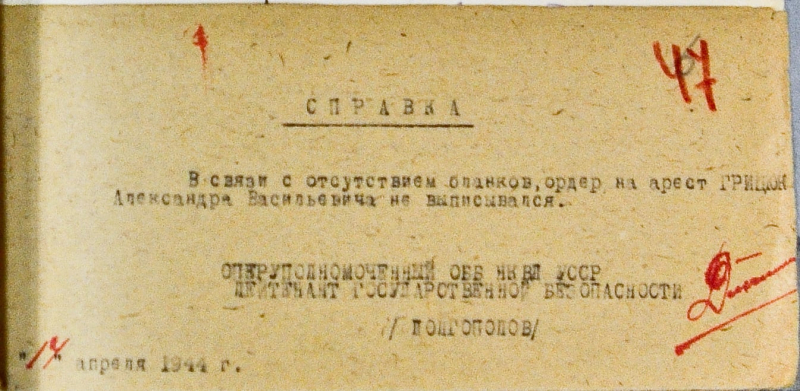
Dzherelo: Documents No. 243, issued by the State Security Service of Ukraine
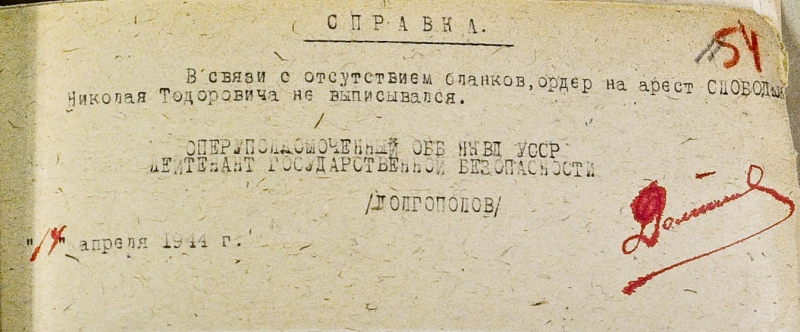
Dzherelo: Documents reference No. 243, issued by the State Security Service of Ukraine
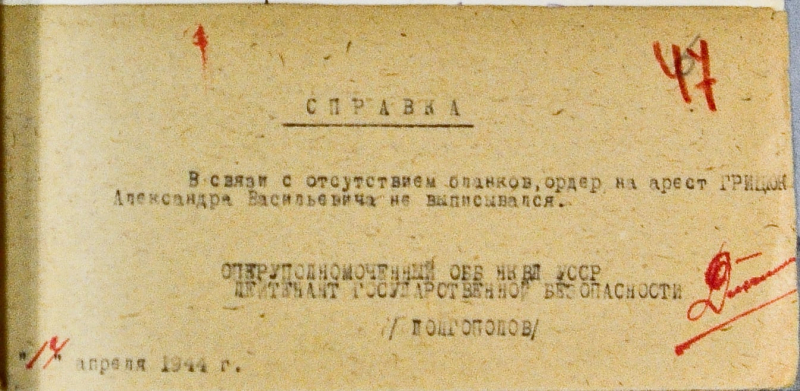
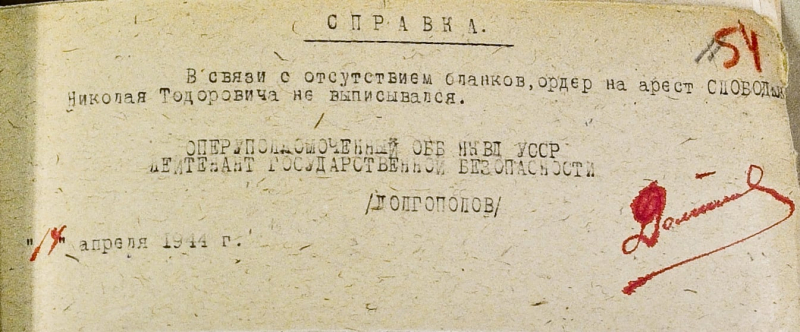
From the documents it is known that Zinchenko, shortly after the arrest of the partisans, namely on April 17, was liquidated by UPA fighters in the area of the same village where he detained the Upovites. The arrest records of UPA members were allegedly lost. The certificate states that they were confiscated from the NKVD member by UPA fighters after his liquidation.

Source: Documents of case No. 243 provided by the State Security Service of Ukraine
Soviet investigation to accuse UPA members in “crimes” attributed to them a large number of allegedly executed civilians in villages such as Peresopnitsa, Dyadkovichi, Verkhovsk, Yaseninichi and other settlements in the Rivne region.
So, in the case there is an act drawn up in the village of Dyadkovichi on June 17, 1944 about the removal of five bodies from a well on the abandoned estate of the Pole Kurovsky. The NKVD authorities concluded that these were the corpses of “Soviet people tortured by OUN bandits.” On the other hand, Soviet partisans and pseudo-detachments of the UPA, which consisted of disguised NKVS members, operated in the same area.
— According to Dyadkovichi — it has absolutely nothing to do with them. This is simply far-fetched. It is impossible to say 100% who exactly was involved in those murders; most likely, the Soviet side is behind them. She knew the circumstances very well. To find out all the details, it takes a lot of time, sometimes years: so that there is no martial law, so that the circumstances are subject to a full investigation. It’s impossible to establish all this so quickly, but they instantly determined and knew everything. This is thought provoking. But these guys, executed in Rovno, had nothing to do with that at all, — Zhiviuk said.
He also said that Trofimchuk was a deeply religious man who belonged to the Ukrainian Evangelical Reformed Church. And even in the interwar period he was its zealous parishioner.
— He went with arms in hand to fight for Ukraine, despite the fact that a believer still has the commandmentthou shalt not kill– at the first place. But Trofimchuk believed that the situation here is different, because you need to protect yourself, your home, your relatives. Destroying an enemy with weapons is one thing, but killing innocent people — This is completely different. These are their methods (Moscow, — Ed.), they applied them, and then attributed them to others. They do it now and they did it then, — notes the historian.
Moreover, the indictment does not contain at least one name of the person who, according to the NKVD, was allegedly killed by one of the eight executed. There are many inconsistencies in the case, in particular, the figures about the alleged number of local residents killed by UPA members — vary.
So, in a letter to dictator Stalin dated May 15, 1944, with a request to organize show trials in Rovno, Nikita Khrushchev mentioned three convicts. In it he writes that Gritsyuk allegedly killed 26 people, Slobodyuk M. — 13, and Slobodyuk V. — 15. Later, at the trial, Gritsyuk will say the number 28, and Slobodyuk M. — 17. The numbers in the court verdict are also different — Slobodyuk M. allegedly killed 18, and Slobodyuk V. — 7 people.
The notorious prison where political prisoners were kept
NKVD Prison No. 1 in Rivne was considered one of the harshest in Volyn and the Rivne region, where political prisoners were mainly kept. They were tortured, tortured and shot.
Later, a garment factory was organized in the prison building, and now it has been turned over to entertainment establishments, in particular, karaoke and shops. The only memory of the terrible crimes of the occupiers in the building is a memorial plaque.
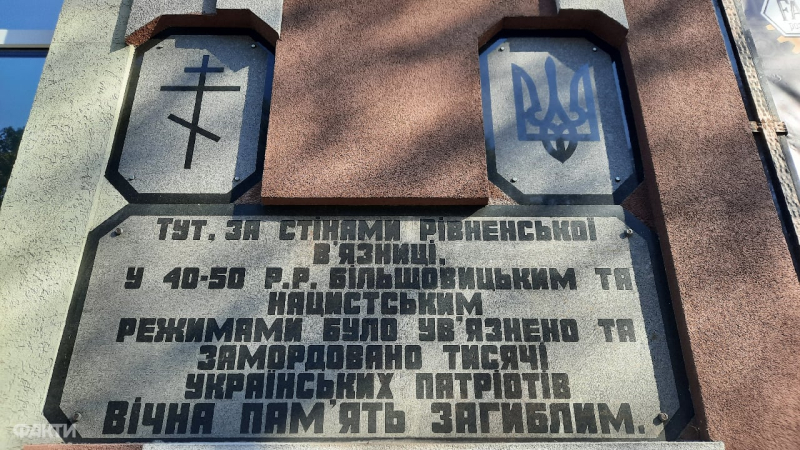
Photo: ICTV Facts
By “intended purpose” it was used by the Polish, Hitler and Soviet regimes. But, unlike the previous two, the communists were especially cruel. They held not 50 or 100 prisoners, but more than 1 thousand “enemies of the people.”
With the new invasion of the Moscow regime in 1944, the prison became an internal prison of the MGB. According to official data from the archives of the Ministry of Internal Affairs of the Rivne region, in the period from September to December 1944 alone, almost 1.5 thousand people were sentenced to death by the military tribunal and the NKVD tribunal in this prison.
On the Internet you can find the memoirs of one of the MGB workers, who describes that the cells resembled a crowded train station, and “people stood tightly and pressed against each other, as if they were waiting for a train to arrive.” When he asked the shift supervisor how they would sleep, he replied:
— Don't worry, by morning not even half of them will be alive.
Among the prisoners of this prison of different regimes were: the founder of the UPA Polesie Sich and the Ukrainian National Guard Taras Borovets, the regional leader of the OUN Nikolai Mostovich, a member of the UPA Yaroslav Starukh, the deputy chief commander of the UPA Rostislav Voloshin, the writer Ulas Samchuk, the public figure Kharitya Kononenko. The accused “Vereshchaki group” also contained in it.
Hyperbolic interrogations with Kremlin narratives
The materials of criminal case No. 243 include, in particular, interrogations of arrested UPA members. Their questionnaires, among general questions, such as place of birth, education, occupation, family members, service in the ranks of the Whites or Reds, also have the itemParticipation in gangs, k.-r organizations and uprisings, next to which is written in pen: UPA.
Their answers, recorded by the NKVD authorities, during interrogations can be called, on the one hand, strange. In some moments they resemble odes to the Soviet regime. It can be assumed that some of them tried to save their lives in this way, but the more obvious fact is that the necessary words were simply fantasized by the occupiers themselves.
The NKVD authorities, in the protocol of interrogation of Stepan Trofimchuk, when asked how his nationalist views originated and about joining the OUN, recorded that he allegedly said the following: “groups of Ukrainian nationalists, followers of Petliura and Konovalets”, “ ;the eyes of the population of Western Ukraine are turned to the Soviet Union and its heroic Red Army”, “representatives of the UNO with malicious anti-Soviet propaganda began to incite hatred among us towards Soviet power”.
This is reminiscent of the Kremlin’s propaganda narratives that they are promoting there even now. The apogee of this is the part where Trofimchuk allegedly said that representatives of the UNO, while campaigning to join their ranks, allegedly “praised the chief of the Germans.” About the Act of Restoration of Independence, proclaimed by the OUN under the leadership of Stepan Bandera, the protocol records that he allegedly said “Bandera’s hopes burst like a soap bubble.”
During the interrogation, they reduced the Russian Zaichikov to the question that he was an “agent of German intelligence.” Logvinovich was interrogated about the connection between the UPA and the Germans, in each question adding “banditry” before the word UPA. Among other things, the NKVDists also brought in contacts with Hungarian units. Thus, Logvinovich allegedly quoted from memory all the notes on this issue, including the dates when they were sent.
— The UPA was looking for allies it considered necessary. At the end of 1944, an agreement was concluded with the Hungarians at the military level that they would cooperate as follows: the UPA does not touch Hungarian units, does not attack them, does not commit any actions against them, and they provide the UPA with military equipment, ammunition, and weapons and others. There was such an agreement. It could easily be turned over and shown: You see, they helped the allies of the Nazis, which means they are collaborating with the Nazis. That in this case the investigation, so to speak, tried to pull the wool over the ears, — told by Andrey Zhivyuk.
As for Nikolai Slobodyuk, the NKVD authorities insisted during interrogation that he was a member of the UPA Security Service. He was asked about the number of corpses thrown into the well of the Kurovsky estate. What he allegedly said: It’s hard to say, but in any case, the number of corpses there is not in tens, but in hundreds. At the same time, the NKVD authorities themselves pointed to only five seized bodies.
Nikolai Slobodyuk was born into a large family and was a native of the village of Dyadkovichi. He admitted to the NKVD that he had only one brother, Ivan, and one sister, Nadezhda. His sister was later raped and killed. He hid the information that there were three more sisters. This probably saved their lives.
Another of those executed, Kirilyuk, was interrogated, among other things, about the battles of UPA kurens against Soviet troops. His response, recorded by the NKVD, talks about the battle of the Gont kuren of 350 people against a “small unit” Red Army soldiers in the village of Zaritsk, Rivne region. It is recorded that the kuren, “having lost several dozen people,” retreated deeper into the forest.
Khrushchev personally lobbied for show executions
The first secretary of the Central Committee of the Communist Party (Bolsheviks) of Ukraine, Nikita Khrushchev, constantly made working visits to the western part of Ukraine and regularly informed Stalin about the need to intensify repression against participants in the Ukrainian national liberation movement.
In one of these documents, he noted that from October 28 to November 5, 1944, he was in Lvov, the regions of the Lvov region and Rivne, “where he became familiar with the state of the struggle of Ukrainian-German nationalists”. He wrote that he considered it necessary to introduce military courts under the NKVD troops.
— To intimidate “bandits” According to the verdicts of these military courts, those sentenced to extermination are not shot, but hanged. Trials must be held openly, with the involvement of the local population. The results of the trials should not be covered in the press. Execution of sentences of military courts shall be carried out publicly in villages, if possible, where the convicted person committed the crimes…
Khrushchev supported the idea of introducing local extrajudicial bodies with the right to apply capital punishment to the accused with immediate execution of the sentence.
In total there were two visiting sessions of the military collegium of the Supreme Court of the USSR. They went to the western regions of Ukraine to make these decisions locally and publicly ensure the execution of sentences by hanging. Andrey Zhivyuk noted that she went to Galicia alone — Lviv, Ternopil, Drohobych, then also Stanislav (Ivano-Frankivsk) regions, and the other went to Volyn — these are Rivne and Volyn regions.
— They stamped these sentences on the spot and immediately carried them out. Local KGB officers slipped them cases that fit this definition. The wording could have been adjusted, — the historian said.
In the Rivne region, this visiting session then sentenced 30 people to death by hanging, and these sentences were carried out accordingly.
— This execution in Rivne on January 4, 1945 was one of them. There were significantly more of these executions. The first execution took place in Korets on December 25, and the last of the line — January 29, 1945 in Klevan. This was also done in other regions of western Ukraine. In total, 128 people were executed, but in the Rivne region, of all the regions of western Ukraine, the most, — he noted.
Trial and execution of the “Vereshchaki group”
The indictment for December 6, 1944 states that the “Vereshchaki group” was created by the Organization of Ukrainian Nationalists from allegedly “former active collaborators of the Germans, police officers, robbers and murderers.” At the same time, none of the ten defendants, as the NKVD authorities indicated after their arrest, had been convicted.
— The investigation established that this gang, which acted under the slogan of the struggle for the creation of an independent (in quotation marks in the act) Ukraine, was essentially one of the sabotage and rebel groups… to fight Soviet partisans.
The following is a list of murders in numbers between May 1943 and January 1944 during the German occupation of the region. At the same time, some of the accused joined the OUN-UPA, as they testified during interrogations, only in the fall of 1943.
The act states that during the liberation of the western regions of Ukraine by the Red Army, the “Vereshchaki group” “continued her treacherous activities” and openly opposed the restoration of Soviet power. In conclusion, all ten were called members of the Ukrainian nationalist “gang” and so-called traitors to the motherland. The indictment was drawn up and signed in Kyiv.
On December 22, 1944, the accused were transported from a prison in Kyiv to a prison in Rovno. The court hearing took place on December 31 — the charges were the same as in the indictment.
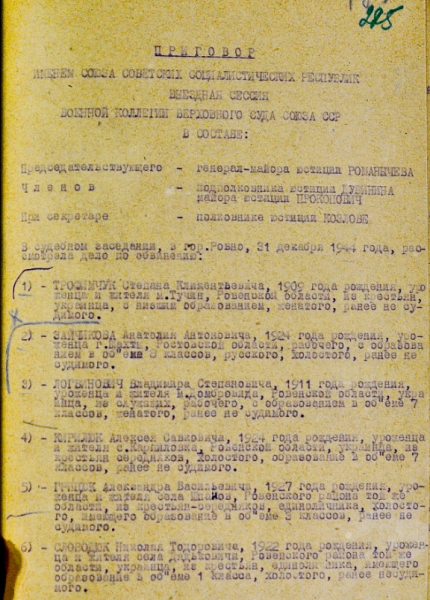
Dzherelo: Documents reference No. 243, issued by the State Security Service of Ukraine

Dzherelo: Documents reference No. 243, issued by the State Security Service of Ukraine
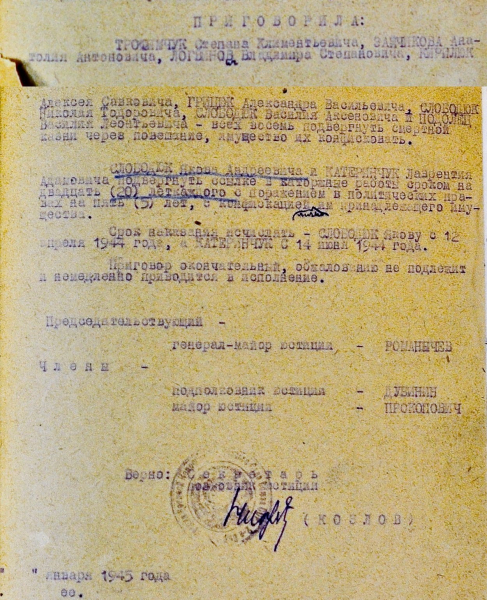
Dzherelo: Documents reference No. 243, issued by the State Security Service of Ukraine
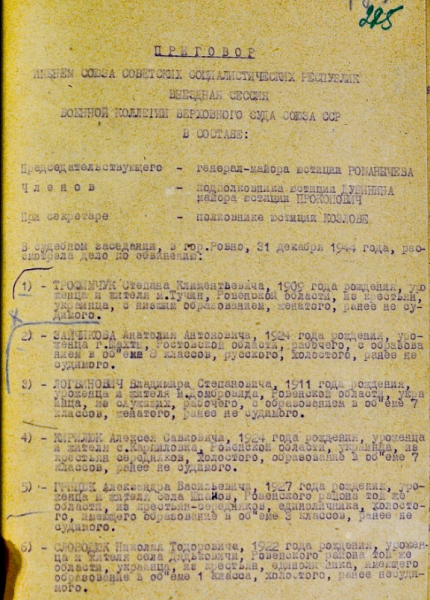
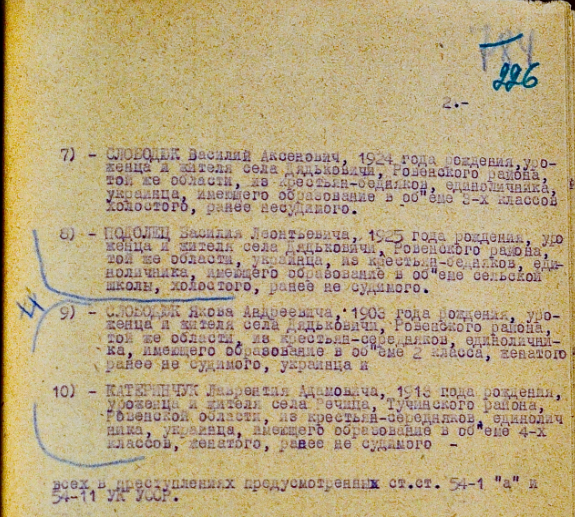
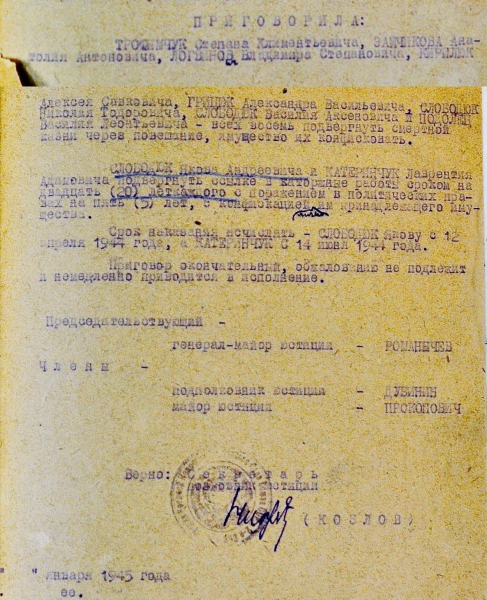
The sentence was death for eight with confiscation of property. Katerynchuk and Yakov Slobodyuk were sent to hard labor for 20 years and their property was confiscated. At the end there was the following: The verdict is final, cannot be appealed and is carried out immediately.
The purpose of the show executions was to intimidate those who resist and oppose Soviet power. Andrei Zhivyuk noted that the Soviet government recorded all UPA gamuz soldiers as collaborators, that is, servants of the Nazis. With these executions they pursued another goal: they wanted to show that the UPA — this is not an enemy of the Nazis, but an ally.
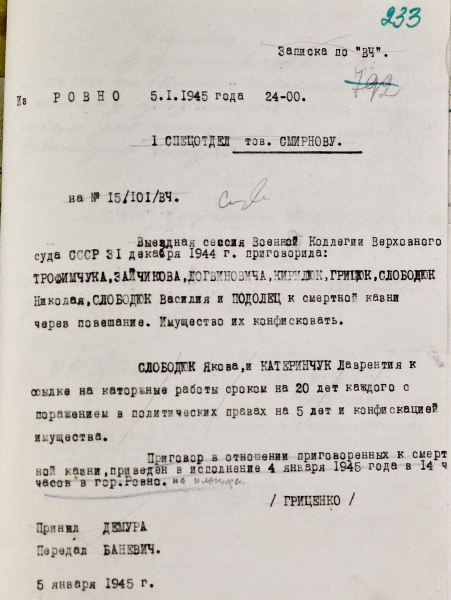
Source: Documents of case No. 243 provided by the State Security Service of Ukraine
Therefore they were hanged, according to Decree of the Presidium of the Supreme Soviet of the USSR dated April 19, 1943, which was called On punitive measures for Nazi villains guilty of murder and torture of the Soviet civilian population and captured Red Army soldiers, for spies, traitors to the motherland from among Soviet citizens and their accomplices
— It’s a long name, but it gave a message about who this punishment was directed against. Thus, in the eyes of the community they are exposed as Nazi collaborators. Intimidate once, compromise twice, expose them as Nazi collaborators, and thus achieve a double effect, — added by the historian.
He also said that the decree of April 19, 1943 provided for two episodes that were not in Soviet legislation either before or after. It was execution by hanging and the introduction of hard labor for a period of 15 to 20 years. These two types of punishments were unique to the Soviet legal system, which were not previously or later established or carried out.
Would a bandit really shout such sacred words?
Before lunch on January 4, the Soviet occupiers gave an instruction to the population to arrive at Theater Square, where the demonstration execution took place. In theRivne Martyrology of the 44th. Documents and memoriesabout this day are the memories of an eyewitnessAnastasia Denishchuk(Pavelko).
Then she was 18 years old and she was a student at a cooperative technical school. They were instructed to line up in groups of four and head to the city center. There they saw a crowd of people: high school students, students, workers, peasants and Red Army soldiers. In the center of the square there were eight wooden structures resembling the letter P, and from each hung a thick cord that ended in a loop.

Photo: ICTV Facts
From the woman’s recollections, before 14:00 two black passenger cars drove up from the direction of the barracks. The military came out of them. One of them read out a document in which eight people were accused of “treason,” massacres, connections with the Hungarians, and the like. At the end he said that it was decided to hang them.
— And then a truck with a stretched awning appeared on the main street. She drove up to one of the gallows and stopped. A hand stuck out from under the awning and grabbed the noose. In a matter of seconds, the car jerked forward sharply, and a man fell out from under the awning and swayed on the gallows… This happened seven times. But when the car approached for the eighth time and when the hand pulled the noose, a loud exclamation was heard from behind the awning: Glory to Ukraine!, and the eighth person hung on the gallows.
According to Denishchuk, then she thought :Are these really bandits? Would a bandit really shout such sacred words? There's something wrong here… She said that the Soviet occupiers did not allow bodies to be removed from the gallows for two weeks. They hung with their hands and feet tied in order to intimidate the patriots who fought for an independent Ukraine and its release from the prison of nations — USSR.
The sister of one of the executed Mykola Slobodyuk,Alexandrawas also among the eyewitnesses of the murder of UPA members by communists. In her memoirs, she said that it was impossible to cry or scream — just watch. In the voice that exclaimed Glory to Ukraine!, she recognized her own brother.
The Ukrainian patriots executed on Theater Square in Rivne have not yet been rehabilitated. After the restoration of Ukrainian independence in the early 1990s, at the request of the daughter of one of those executed, the case was considered, but rehabilitation was denied. But it’s no secret that at that time the decision was made by people who had been in the Soviet system for a long time.
Perhaps the time has come to implement it now? And thus honor their memory, because where are they buried, and were they — unknown. It’s like lines from a song: There are no crosses over their brushes, and there’s nowhere for us to bring brushes. And so at least the stamps of the Russian occupiers will be removed from their names.

